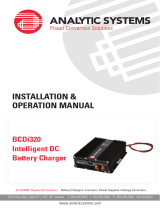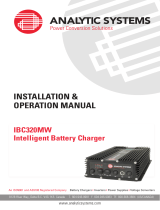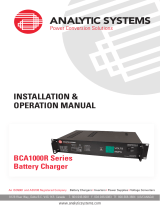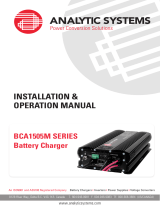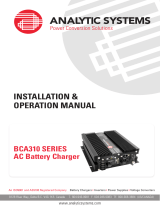Page is loading ...

INSTALLATION &
OPERATION MANUAL
101-8128 River Way, Delta B.C. V4G 1K5 Canada T. 604.946.9981 F. 604.946.9983 TF. 800.668.3884 (US/CANADA)
www.analyticsystems.com
An ISO9001:2015 Registered Company Battery Chargers • Inverters • Power Supplies • Voltage Converters
BCD315MW &
BCD315MY
DC-SOURCE
BATTERY CHARGER

2
SAVE THESE INSTRUCTIONS — This manual contains important safety and operating
instructions for the battery charger.
BATTERY CHARGER PRECAUTIONS
1. Do not expose the battery charger to rain or snow unless it is a sealed model.
2. Use of an attachment not recommended or sold by the battery charger manufacturer may
result in a risk of re, electric shock, or injury to persons.
3. Do not disassemble the battery charger; return it to the manufacturer or an authorized
service center when service or repair is required. Incorrect reassembly may result in a risk
of electric shock or re. Voltages in excess of 350 volts are present inside the charger any
time it is plugged into a power source, even if it is switched off.
4. To reduce risk of electric shock, unplug the battery charger from the power source before
attempting any maintenance or cleaning. Turning off controls will not reduce this risk.
5. Never place battery charger directly above battery; gases from battery will corrode and
damage battery charger.
6. Never allow battery acid to drip on to the battery charger.
1. WARNING — RISK OF EXPLOSIVE GASES
i. WORKING IN VICINITY OF A LEAD-ACID BATTERY IS DANGEROUS. BATTERIES
GENERATE EXPLOSIVE GASES DURING NORMAL BATTERY OPERATION. FOR THIS
REASON, IT IS OF UTMOST IMPORTANCE THAT EACH TIME BEFORE SERVICING
EQUIPMENT IN THE VICINITY OF THE BATTERY, YOU READ THIS USER GUIDE AND
FOLLOW THE INSTRUCTIONS EXACTLY.
ii. To reduce risk of battery explosion, follow these instructions and those published by
the battery manufacturer and manufacturer of any equipment you intend to use in
vicinity of battery. Review the cautionary marking on these products.
2. PERSONAL PRECAUTIONS
i. Someone should be within range of your voice or close enough to come to your aid
when you work near a battery.
ii. Have plenty of fresh water and soap nearby in case battery acid contacts skin,
clothing, or eyes.
iii. Wear complete eye protection and clothing protection. Avoid touching eyes while
working near battery.
DC SOURCE BATTERY CHARGER
IMPORTANT SAFETY INSTRUCTIONS
BATTERY SAFETY

3
MEDICAL EQUIPMENT NOTICE
Analytic Systems does not recommend the use of their products in life support
applications where failure or malfunction of the product can be reasonably
expected to cause failure of the life support device or to signicantly affect its
safety or effectiveness. Analytic Systems does not recommend the use of any of
its products in direct patient care.
Examples of devices considered to be life support devices are neonatal oxygen
analyzers, nerve stimulators (whether used for anesthesia, pain relief, or other
purposes), auto-transfusion devices, blood pumps, debrillators, arrhythmia
detectors and alarms, pacemakers, hemodialysis systems, peritoneal dialysis
systems, neonatal ventilator incubators, ventilators for both adults and infants,
anesthesia ventilators, and infusion pumps as well as any other devices
designated as “critical” by the U.S. FDA.
iv. If battery acid contacts skin or clothing, wash immediately with soap and water. If
acid enters eye, immediately ood eye with running cold water for at least 10
v. NEVER smoke or allow a spark or ame in the vicinity of a battery.
vi. Be extra cautious to reduce risk of dropping a metal tool onto battery. It might spark
or short-circuit the battery or other electrical part that may cause a re or explosion.
vii. Remove personal metal items such as rings, bracelets, necklaces, and watches
when working with a lead-acid battery. A lead-acid battery can produce a short-
circuit current high enough to melt metal, causing a severe burn.
viii. NEVER charge a frozen battery.
ix. If it is necessary to remove a battery from service, always remove grounded terminal
from battery rst. Make sure all accessories connected to the battery are off, to
prevent an arc when reconnecting the new battery.
x. Be sure area around battery is well ventilated.
xi. Clean the battery terminals. Be careful to keep corrosion from coming in contact
with eyes.
xii. Study all the battery manufacturer’s specic precautions such as removing or not
removing cell caps while charging and recommended rates of charge

4
TABLE OF CONTENTS
• Front Cover, Product Photo and Title
• Product warnings and advisories
• Table of Contents
• Introduction/Box Contents
• Main Parts
• Operation/Operational Indicators
• Charging Proles
• Connections
• Installation
• Battery Temperature Sensor/Equalize Cycle
• Troubleshooting
• Specications
• Special Services and Options
• Warranty
Revised - Aug 9, 2023
Copyright (2005-2022) Analytic Systems Ware (1993) Ltd.

5
Introduction
The BCD315MW is a C.O.T.S DC-source battery charger designed to provide up to 300 watts
of precision charging power to a one or two bank battery system at 12, 24, 32, 36, or, 48 VDC.
The batteries must share a common ground.
The updated single board design incorporates state-of-the-art switch- mode technology for
unmatched efciency and ultra-quiet operation. In the absence of a battery, this unit can also
be used as a DC-DC voltage converter up to the continuous current rating.
The BCD315MW features expanded operating temperature, MIL-spec connectors, and
military-grade shock and vibration protection. Additionally, this unit is sealed to meet the IP66
rating (IP67 certication is available as an option for this product line)
Safety features include over-temperature shutdown, current limiting, short circuit protection
with automatic recovery, input under voltage shutdown, output over-voltage protection and
battery reverse connection protection. Extra features include visual indicators for low input
voltage, charging and overtemperature, dry contact output fail output and remote control
connection.
Box Contents
The box you have received should contain the following:
• One BCD315MW or BCD315MY DC-DC Battery Charger
• One Waterproof Battery Temperature Sensor (BTEMP-W)
• This Manual
• One Warranty Card
If anything is missing or damaged please contact your dealer or Analytic Systems for a replacement

6 7
Main Parts
1. Indicator LEDs
2. Battery Temperature Sensor Connection
3. Output Fuse
4. DC Output Connection
5. Output Voltage Adjust
6. Equalize Cycle Start Button
7. Charging Prole select switch
8. Power Switch
9. Input Fuse
10. DC Input Connection
FRONT PANEL
1
5
1
9
4
8
37
10
2
6

6 7
Operation
This battery charger is designed for simple operation. Before operating, the unit must be
properly installed and connected. See Installation for more information regarding mounting
and connections.
TO CHARGE A BATTERY
1. Choose which type of charging prole will be used during charging by moving the Stage
Select switch. See Charging Proles for more information about two-stage and three-
stage charging.
2. Move the power switch to ON. The alarm buzzer will sound and the LOW VOLTAGE
OUTPUT LED will glow red briey, then the POWER LED will glow green. This is normal.
3. The CHARGING LED will glow green indicating normal operation. The unit will
automatically charge the connected battery until it is fully charged. This may take several
hours.
4. When the battery is fully charged, the CHARGING LED will turn off. The unit will maintain
the battery at full charge for as long as it is connected.
TO ADJUST THE CHARGING (FLOAT) VOLTAGE
1. Disconnect the battery temperature sensor(s) from the unit, if in use.
2. Locate the Output Voltage Adjustment potentiometer on the front panel. On some units,
this is covered by a protective cap to prevent accidental operation.
3. Rotate the knob to adjust the charging voltage. The charging (oat) voltage can be
adjusted over a range of ±1.0 volts.
4. Rotate the potentiometer clockwise to increase the charging voltage; counterclockwise
to decrease the voltage.
5. Using a multimeter, read the charging voltage at the battery terminal. On units with the
optionall digital multimeter, that can be used to read the voltage instead.
6. When satised with the new voltage reading, return the protective cap in place and
reconnect the battery temperature sensor(s) if needed.
TO END OPERATION
1. Move the power switch to OFF.
2. Wait for all the Indicator LEDs stop glowing.
3. It is now safe to disconnect the unit from the power source and battery. The unit is now
ready for storage or service.

8 9
POWER ON
This LED glows green when the unit is connected to an AC power source and turned ON.
CHARGING
This LED glows green when the unit is charging a battery. This LED turns off when the
connected battery is fully charged. The charger will maintain the battery at full charge for as
long as it is connected.
OVERTEMP
This LED glows red if the unit’s internal temperature is above the safe limit, the unit will then
turn off its output as a precaution. If the internal temperature returns to the safe operating
range, the unit will automatically resume operation.
UNDERVOLTAGE OUTPUT
This LED glows red if the unit detects the output voltage is too low for proper operation, the
unit will then shut off its output as a precaution. If the unit detects the output voltage return
to normal operating range, it will automatically resume operation.
UNDERVOLTAGE INPUT
This LED glows red if the unit detects the the input voltage is too low for proper operation, the
unit will then shut off its output as a precaution. If the unit detects the input voltage return the
normal operating range, it will automatically resume operation.
EQUALIZE
BATTERY TEMPERATURE SENSOR MUST BE INSTALLED TO USE THIS FUNCTION.
This LED glows red when the unit is performing an equalize cycle. This LED blinks red when
the unit is waiting for a battery to nish charging before performing an equalize cycle.
BATTERY OVERTEMP
BATTERY TEMPERATURE SENSOR MUST BE INSTALLED TO USE THIS FUNCTION.
This LED glows red when the battery’s temperature is above the safe limit, the unit will then
turn off its outputs as precaution. If the battery temperature returns to the safe operating
range, the unit will automatically resume operation.
Operational Indicators
This unit’s top panel features seven indicator LEDs on its front panel to display the unit’s
operating condition. The meanings of these LEDs are detailed below. For more information
regarding the malfunctions these LEDs can indicate and how to correct them, see
Troubleshooting.

8 9
Charging Proles
This unit has both two-stage and three-stage charging capability. You can choose which type
of charging is used during operation by using the Stage Select switch located on the front
panel. Below are explanations of the two charging proles:
1. The battery is charged at constant
current until the battery’s voltage
reaches the oat voltage.
2. The charging current diminishes as
necessary to maintain the battery at
that voltage.
TWO-STAGE CHARGING
Two-stage charging eliminates any risk of
overcharging the battery if it is connected to
a load while being charged.
THREE-STAGE CHARGING
1. The battery is charged at constant
current until the battery voltage
reaches the absorption voltage.
2. Then the charging current diminishes
as necessary to maintain the battery
at that voltage.
3. Once the charging current drops
below 10% of the rated output,
the charging cycle is complete. The
charger then switches to the oat
voltage to maintain the battery at
full charge.
Three-stage charging is more complete than two-stage, but the charging current must drop
below 10% of the rated output current of the charger for the Absorption Mode to terminate.
For that reason, three-stage charging is not recommended for charging loaded batteries
because the unit cannot differentiate between current going to a load connected to the
battery and current being absorbed by the battery, which may cause overcharging.

10 11
Connections
INPUT CONNECTION
The DC Input connection is intended for connection to the DC power source that is powering
the battery charger.
This unit is equipped with an Amphenol Industrial Circular MIL-spec GTS02R16-11P connector
to serve as a DC input connection. This connector’s pin-out is as follows:
Pin Function
A Positive 1
B Negative
C Negative
D Positive 2
OUTPUT CONNECTION
The DC Output connection is intended for connection to the batteries being charged. This unit
is equipped a Amphenol Industrial Circular MIL-spec GTS02R-14S-2S (027) connector to serve
as a DC Output connection. This connector’s pin-out is as follows
The charger may be used to charge to either one or two battery banks simultaneously. If
charging two battery banks keep in mind that they MUST share a common ground! If charging
only a single bank, it is recommended you connect it to both outputs in parallel to reduce
stress on the output isolation diodes inside the charger.
Pin Function
A Positive
B Negative

10 11
MOUNTING
Mount the unit and allow at least 1 inch
of clearance around the heat sink ns for adequate
cooling.
CAUTION: NEVER CONNECT OR DISCONNECT
ANYTHING TO THE UNIT’S INPUT OR OUTPUT
WHILE IT IS ON!
To prevent the risk of high voltage electric shock, never
connect or disconnect anything to/from the unit’s input
or output connections while the power switch is ON.
GROUNDING
The unit case is connected to AC Ground and AC Neutral in order to meet regulatory
requirements and reduce the possibility of it generating any radio frequency interference.
The unit case must be bonded appropriately to the grounding system of the vehicle or marine
vessel. On a vehicle, bond the case to the vehicle’s frame. On a marine vessel, bond the case
to the vessel’s hull. A grounding stud is provided on the front panel for this purpose.
To ensure proper grounding, check the connection with an ohmmeter. The case is isolated from
the DC input, so the DC power can be connected to a different ground from the AC output.
DISCONNECTING
If you need to disconnect the unit for service or storage:
1. Move the power switch to OFF and disconnect the power source and load
2. With power disconnected, move the power switch to ON.
3. Leave the switch in this position for one minute to discharge the storage capacitors.
4. Return the power switch to the OFF position.
5. The power supply or battery charger is ready for service or storage.
Installation

12 13
Battery Temperature Sensor
This unit is supplied with one battery temperature sensor. The sensor communicates the
temperature of the battery to the battery charger and is necessary for the charger’s voltage
temperature compensation, battery over temperature shutdown and equalize cycle functions.
BATTERY TEMPERATURE SENSOR CONNECTION
This unit is equipped with an Amphenol MIL-Spec PT02A8-4S connector to connect to up to two
Analytic Systems waterproof battery temperature sensors. This connection’s pinout can be found
on the unit label.
TO INSTALL THE SENSOR AT THE BATTERY:
• Slide the sensor ush between the side of the battery and wall of the battery platform.
• Place the battery on top of the sensor to hold it in place.
• Apply a small amount of silicone RTV sealant to the sensor and stick it to the top of the
battery.
There are multiple ways to install the sensor at the battery. Regardless of which method you
use, the sensor must be rmly secured and should not lose physical contact with the battery at
any point in the charging cycle.
VOLTAGE TEMPERATURE COMPENSATION
Heat is a normal by-product of the charging cycle. However, excessive heat can cause
overcharging, damaging the battery. With a battery temperature sensor installed, the battery
charger will automatically reduce the charging voltage to compensate for rising temperature.
The ambient battery temperature is pre-set to 77°F (25°C). For each degree above 77°F (25°C),
the charger will reduce the charging voltage by a small amount. See Specications for more
information regarding, the default temperature compensation coefcient of your unit. You can
change the voltage temperature compensation coefcient and set its operating thresholds using
Analytic Systems’ free-to-download software PowerWizard.
Pictured: An Analytic Systems
waterproof battery temperature sensor
(Product:B-TEMPW)

12 13
Equalize Cycle
If a battery is left discharged for too long, sulfate crystals can form on its internal electrode plates.
This interferes with the plate’s conductance reducing battery’s charging capacity and speed.
This battery charger can perform an equalize cycle to correct this condition. An equalize cycle
ensures all the cells of the battery are fully charged by deliberately overcharging the battery at
a low current (approximately 10% of its normal output) until it reaches the unit’s programmed
Equalize Voltage.
The charger then maintains the battery at that voltage for three hours after which time the
equalize cycle ends and the battery charger resumes normal operation; maintaining the battery
at the oat voltage.
DANGER: THE BATTERY MUST BE IN A WELL VENTILATED AREA!
Hydrogen gas is a normal by-product of the equalize cycle and is explosive at concentrations
greater than 4% of the local atmosphere.
CAUTION: A BATTERY TEMPERATURE SENSOR MUST BE INSTALLED AND USED!
Heat is a normal by-product of the equalize cycle, however excessive heat will damage the
battery bank. The battery temperature sensor must be connected and installed to allow the
unit to monitor the battery temperature to ensure it is within safe operating limits.
TO PERFORM AN EQUALIZE CYCLE:
1. Connect the supplied Analytic Systems battery temperature sensor and install it at the
battery. See Battery Temperature Sensor, for more information on how to do this. .
2. Push the Equalize button on the front panel. On some units, this button is recessed to
prevent accidental operation; a ballpoint pen or any other thin rod can be used to access it.
3. If the unit is not currently charging a battery, the EQUALIZE LED will glow red indicating
the unit is starting an equalize cycle.
4. If the unit is currently charging a battery, the EQUALIZE LED will blink red indicating the
unit is waiting to start an equalize cycle. When the charging cycle ends, the CHARGING
LED will shut off and the EQUALIZE LED will glow red and the equalize cycle will
automatically begin.
5. Three hours later, the equalize cycle will end. The battery charger will automatically
resume normal operation maintaining the battery at the full charge.

14 15
This unit is tted with several LED indicators and an alarm buzzer to display and diagnose
any problems during operation. In the event of a malfunction, the unit will sound the alarm
buzzer prior to shutting itself down. You should immediately check which LEDs are glowing to
determine the cause of the malfunction, which are detailed in the chart below.
LED Indicator Meaning
BATTERY OVERTEMP The battery’s temperature is too high for safe charging.
Fix: The battery may be defective or there may not be adequate ventilation to
dissipate the heat created during charging.
Check that the battery using a multimeter to ensure is not defective. If it is
working correctly, reposition the battery for better air circulation.
OVERTEMP The battery charger’s internal temperature is too high for normal operation.
Fix: The internal cooling fan may have failed or there may not be adequate
ventilation to cool the charger. Check that the cooling fan is still working; if it
is not working then the unit must be returned to an authorized service center
for repair.
If it is working correctly, remount the battery charger for better air circulation.
LOW INPUT VOLT The battery charger’s input voltage is too low for normal operation.
Fix: Check that the power source is properly rated for the battery charger. Check
that the input wiring and connection are free of damage and corrosion.
If all of the above are in proper working order, the cause is likely an internal
component failure and the unit must be returned to an authorized service
center for repair.
LOW OUTPUT VOLT The battery charger’s output voltage is too low for normal operation.
Fix: The charging current may be exceeding the unit’s maximum rating causing
the output voltage to drop to maintain the current at that level. Check that
the charging current is not over its rating, by using a multimeter at the
output connection. If it is, reduce the load connected to the charger.
Check that the output cables and connections are free of damage and
corrosion. If all of the above are in proper working order, the cause is
likely an internal component failure and the unit must be returned to an
authorized service center for repair.
Troubleshooting

14 15
Limited Warranty
Analytic Systems supports the high-quality products with the following limited product warranty:
1. The equipment manufactured by Analytic Systems Ware (1993) Ltd. (the “Warrantor”) is warranted to be free
from defects in workmanship and materials under normal use and service.
2. This warranty is in effect for:
a. 5 Years from date of purchase by the end user for standard products offered in our catalog..
b. 2 Years from date of manufacture for non-standard, Military, and OEM products
c. 1 Year from date of manufacture for encapsulated and repaired/refurbished products.
3. Analytic Systems will determine eligibility for warranty from the date of purchase:
a. Shown on the warranty card when returned within 30 days, or
b. The date of shipment by Analytic Systems, or
c. The date of manufacture coded in the serial number, or
d. From a copy of the original purchase receipt showing the date of purchase by the user.
4. In case any part of the equipment proves to be defective, the Purchaser should do the following:
a. Prepare a written statement of the nature of the defect to the best of the Purchasers knowledge, and
include the following:i. date of purchase, ii. place of purchase, iii. the Purchasers name, address and
phone number.
b. Call Analytic Systems at 1-800-668-3884 / 1-604-946-9981 or email [email protected] to
request a return material authorization number (RMA #).
c. Return the defective item along with the statement at the Purchaser’s expense to the Warrantor; Analytic
Systems Ware (1993) Ltd., 101-8128 River Way, Delta, BC, V4G 1K5, Canada.
5. If upon the Warrantor’s examination the defect proves to be the result of defective material or workmanship,
the equipment will be repaired or replaced at the Warrantor’s option without charge, and returned to the
Purchaser at the Warrantor’s expense by the most economical means. Requests for a different method of return
or special handling will incur additional charges and are the responsibility of the Purchaser.
6. Analytic Systems reserves the right to void the warranty if:
a. Identication marks or serial numbers are removed or altered in any way.
b. Our invoice is unpaid.
c. The defect is the result of misuse, neglect, improper installation, environmental conditions, non-authorized
repair, alteration or accident.
7. No refund of the purchase price will be granted to the Purchaser, unless the Warrantor is unable to remedy the
defect after having a reasonable number of opportunities to do so.
8. Only the Warrantor shall perform warranty service. Any attempt to remedy the defect by anyone else shall
render this warranty void.
9. There shall be no warranty for defects or damages caused by faulty installation or hook-up, abuse or misuse of
the equipment including exposure to excessive heat, salt or fresh water spray, or water immersion except for
equipment specically stated to be waterproof.
10. No other express warranty is hereby given and there are no warranties that extend beyond those described
herein. This warranty is expressly in lieu of any other expressed or implied warranties, including any implied
warranty of merchantability, tness for the ordinary purposes for which such goods are used, or tness for a
particular purpose, or any other obligations on the part of the Warrantor or its employees and representatives.
11. There shall be no responsibility or liability whatsoever on the part of the Warrantor or its employees and
representatives for injury to any person or persons, or damage to property, or loss of income or prot, or any
other consequential or resulting damage which may be claimed to have been incurred through the use or sale of
the equipment, including any possible failure of malfunction of the equipment, or part thereof.
12. The Warrantor assumes no liability for incidental or consequential damages of any kind.

16 17
This page has been intentionally left blank.

16 17
This page has been intentionally left blank.

18 19
This page has been intentionally left blank.

18 19
Specications
Output
Nominal Voltage 12 VDC 24 VDC 36 VDC 48 VDC
Absorption Voltage 14.4 VDC 28.8 VDC 43.2 VDEC 57.6 VDC
Float Voltage 13.6 ± 0.05 VDC 27.2 ± 0.05 VDC 40.8 ± 0.05 VDC 54.4 ± 0.05 VDC
Absorption to Float 3.0 Amps 1.0 Amps 1.0 Amps 0.75 Amps
Voltage Adjustment Range ± 1.0 VDC
Output Fuses (AGC) 25-Amp 15-Amp 10-Amp 7-Amp
Charging Amps 20 A 10 A 6.7 A 5 A
Battery Banks 1 or 2
Recommended Battery Capacity 80-100 Amp-Hrs 40-60 Amp-Hrs 50-80 Amp-Hrs 20-30 Amp-Hrs
Overvoltage Protection Crowbar 16.0 ±1.0 V 32.0 ±1.0 V 48.0 ±2.0 V 64.0 ±1.0 V
Temperature Compensation Coefcient -30 mV/°C -45 mV/°C -60mV/ °C -120 mV/°C
Duty Cycle Continuous
Efciency > 75% @Maximum Output
Charging Proles 2 or 3 Stage Charging
Mechanical
Length 12.5 in / 31.8 cm
Width 8.2 in/ 20.8 cm
Height 3.2 in / 8.1 cm
Clearance 1.0 in / 2.5 cm (All around)
Weight 10.0 lb / 4.5 kg
Material and Finish Marine Grade Black Anodized Aluminum
Fasteners 18-8 Stainless Steel
Connections
Input: Amphenol Industrial Circular MIL-spec GTS02R16-11P connector
Output: Amphenol Industrial Circular MIL-spec GTS02R-14S-2S (027)
connector
Battery Temperature Sensor: Amphenol Industrial Circular MIL-spec
PT07A-8-4S(027) connector
Environmental and Safety
Operating Temperature Range -40°C to +55°C @ maximum output. Derate Linearly 2.5% per °C from
+55°C
Moisture Protection W-Version: Built to meet IP66 rating, Y-Version: Certied to meet IP67
rating
Isolation Input-Case, Input-Output and Output-Case: 1500 VDC
Audible Noise None, 0 dB @ 3 ft
Typical Service Life > 10 years (87,600 hrs)
Warranty Five years parts and labor
Safety Complies with FCC Class B, Part 15
Input
Nominal Voltage 12 VDC 24 VDC 36 VDC 48 VDC 72 (rail) VDC
Actual Voltage 11-16 VDC 20-35 VDC 30-45 VDC 40-60 VDC 65-90 VDC
Input Amps (Max) 30 A 18.7 A 12.5 A 9.4 A 5.7 A
Input Fuse (MDA) 20-Amp (x2) 25-Amp 20-Amp 15-Amp 10-Amp
Noise in Input <25 mV

Register Products Online | www.analyticsystems.com/support/warranty-registration
DESIGNED AND MANUFACTURED BY
800-668-3884
604-946-9983
www.analyticsystems.com
101-8128 River Way
Delta, B.C. V4G 1K5 | Canada
Battery Chargers • Inverters • Power Supplies • Voltage Converters
/
